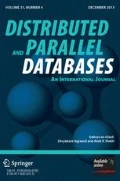Abstract
Organizations increasingly define many business processes as projects executed by “virtual (project) teams”, where team members from within an organization cooperate with “outside” experts. Virtual teams require and enable people to collaborate across geographical distance and professional (organizational) boundaries and have a somewhat stable team configuration with roles and responsibilities assigned to team members. Different people, coming from different organizations will have their own preferences and experiences and cannot be expected to undergo a long learning cycle before participating in team activities. Thus, efficient communication, coordination, and process-aware collaboration remain a fundamental challenge. In this paper we discuss the current shortcomings of approaches in the light of virtual teamwork (mainly Workflow, Groupware, and Project Management) based on models and underlying metaphors. Furthermore, we present a novel approach for virtual teamwork by tightly integrating all associations between processes, artifacts, and resources. In this paper we analyze (a) the relevant criteria for process-aware collaboration system metaphors, (b) coordination models and constructs for organizational structures of virtual teams as well as for ad hoc and collaborative processes composed out of tasks, and (c) architectural considerations as well as design and implementation issues for an integrated process-aware collaboration system for virtual teams on the Internet.
Similar content being viewed by others
References
W.M.P. van der Aalst, A.H.M. Hofstede, B. Kiepusziewski, and A.P. Barros, “Workflow patterns,” Distributed and Parallel Databases, vol. 14, no. 1, pp. 5-51, 2003.
W.M.P. van der Aalst and A. Kumar, “A reference model for team-enabled workflow management systems,” Data & Knowledge Engineering, vol. 38, pp. 335-363, 2001.
G. Bafoutsou and G. Mentzsa, “Review and functional classification of collaborative systems,” International Journal of Information Management, vol. 22, pp. 281-305, 2002. Elsevier Science.
Baker et al., “Customized process and situation awareness,” International Journal of Cooperative Information Systems, M. Papazoglou and G. Schlageter (Eds.), World Scientific, March 2002, vol. 11, nos. 3 and 4.
R. Bentley, W. Appelt, U. Busbach, E. Hinrichs, D. Kerr, K. Sikkel, J. Trevor, and G. Woetzel, “Basic support for cooperative work on the World Wide Web,” International Journal of Human-Computer Studies, vol. 46, pp. 827-846, 1997.
G.A. Bolcer, “Magi: An architecture for mobile and disconnected Workflow,” IEEE Internet Computing, pp. 46-54, May and June 2000.
Caramba Labs Software AG, 2002, http://www.CarambaLabs.com
K.C.C. Chan and L.M.L. Chung, “Integrating process and project management for multi-site software development,” Annals of Software Engineering, vol. 14, pp. 115-142, 2002.
F. Casati, S. Ceri, B. Pernici, and G. Pozzi, “Workflow evolution,” Data and Knowledge Engineering, vol. 24, no. 3, pp. 211-238, 1998.
N. Craven and D.E. Mahling,“Goals and processes: A task basis for projects and workflows,” in Proceedings COOCS International Conference, Milpitas, CA, USA, 1995.
U. Dayal, “Business process coordination: State of the art, trends, and open issues,” in Proceedings of the 27th VLDB Confererence, Roma, Italy, 2001.
G. DeSanctis and R.B. Gallupe, “Afoundation study of group decision support systems,” Management Science, vol. 23, no. 5, pp. 589-609, 1987.
S. Dustdar, “Towards integration of artifacts, resources, and processes for virtual teams,” in Virtual Team: Projects, Protocols, and Process, David Pauleen (Ed.), Idea Group Publishing, 2003.
S. Dustdar, “Collaborative knowledge flow–Improving process-awareness and traceability ofwork activities,” in 4th International Conference on Practical Aspects of Knowledge Management (PAKM 2002), December, Springer LNCS, 2002.
S. Dustdar and H. Gall, “Architectural concerns in distributed and mobile collaborative systems,” Journal of Systems Architecture, Elsevier, vol. 49, pp. 457-473, 2003.
C. Ellis (Skip), “A framework and mathematical model for collaboration technology,” in Coordination Technology for Collaborative Applications–Organizations, Processes, and Agents, Conen and Neumann (Eds.), Springer Verlag, 1998, pp. 121-144.
C.A. Ellis, S.J. Gibbs, and G.L. Rein, “Groupware: Some issues and experiences,” Communications of the ACM, vol. 34, no. 1, 1991.
C.A. Ellis and C. Maltzahn, “The Chautauqua workflow system,” in Proc. 30th Int'l Conf. on System Science, Maui, 1997.
D. Georgakopoulos et al., “Managing escalation of collaboration processes in crisis mitigation situations,” in Proceedings of the 16th International Conference on Data Engineering, 2000.
D. Georgakopoulos, M. Hornick, and A. Sheth, “An overview of workflow management: From process modeling to workflow automation infrastructure,” Distributed and Parallel Databases, vol. 3, pp. 119-153, 1995.
Groove, 2002, http://www.groove.net.
D. Gelernter and N. Carriero, “Coordination Languages and their significance,” Communications of the ACM, vol. 35, no. 2, 1992, 97-107.
IBM Corporation, http://www.ibm.com.
R. Johansen, Groupware. Computer-Support for Business Teams, The Free Press: New York, 1988.
F. Maurer and H. Holz, “Integrating process support and knowledge management for virtual software development teams,” Annals of Software Engineering, vol. 14, pp. 145-168, 2002.
G. Nagypal et al., “Integrating workflow and groupware functionalities for co-operating small and medium sized enterprises: A case study,” in Proceeding of Seventh International Workshop on Groupware, IEEE Computer Society Press, Sept. 2001, pp. 38-43.
M. Reichert and P. Dadam, “Adeptflex-Supporting dynamic changes of workflows without losing control,” Journal of Intelligent Information Systems, vol. 10, pp. 93-129, 1998.
G.D.Venolia, L. Dabbish, J.J. Cadiz, and A. Gupta, “Supporting Emailworkflow,” Microsoft Technical Report MSR-TR-2001-88.
R. Woitsch and D. Karagiannis, “Process-oriented knowledge management systems based on KM-services: The promote approach,” in Proceedings of the International Conference on Practical Aspects of Knowledge Management (PAKM), LNAI 2569, Springer-Verlag, pp. 398-412, 2002.
M. Weske, “Flexible modeling and execution of workflow activities,” in Proceedings of the 31st Hawaii International Conference on System Sciences, HICSS, 1998, vol. 7.
Workflow Management Coalition (WfMC), Workflow Management Specification Glossary, http://www.wfmc.org.
Author information
Authors and Affiliations
Rights and permissions
About this article
Cite this article
Dustdar, S. Caramba—A Process-Aware Collaboration System Supporting Ad hoc and Collaborative Processes in Virtual Teams. Distributed and Parallel Databases 15, 45–66 (2004). https://doi.org/10.1023/B:DAPD.0000009431.20250.56
Issue Date:
DOI: https://doi.org/10.1023/B:DAPD.0000009431.20250.56




